
This is a 'rough draft' of the night I found my first tiger salamander (
Ambystoma tigrinum). I wrote this up about 10 months ago. It has 'rough' parts that are unneeded or are in need of different wording, but whatever, thought I'd share...
Even though I sit here with a cup of hot tea, some tissues, and antibiotics by my side, I can still say it’s better to be stalking tigers in the swamp, than the contrary; Tigers stalking you in the swamp! With that said I can too say that spotting and catching an Eastern Tiger salamander is worth the runny nose, fever, and use of legal medical drugs; if the cold and wet weather did indeed sicken me or at least had a part in the reason why I’m sick.
The Eastern Tiger salamander, scientifically known as
Ambystoma tigrinum, is the walking, burrowing, arthropod munching beast of the terrestrial salamanders. It is a rather large species as far as terrestrial salamanders go and is the largest in its group of salamanders, the Ambystomid salamanders. This group includes the well known Spotted salamander (
Ambystoma maculatum) and the Marbled salamander (
Ambystoma opacum). The Eastern Tiger salamander is one of six subspecies, others include; the Gray Tiger salamander (
A. t. diaboli), the Barred Tiger salamander (
A. t. mavortium), the Blotched Tiger salamander (
A. t. melanostictum), the Arizona Tiger salamander (
A. t. nebulosum), and the Sonoran Tiger salamander (
A. t. stebbinsi) (Crother 2000). Within the southeast we only have the Eastern Tiger salamander subspecies, but this species ranges throughout much of the US (Conant 1991).
It had been a long time coming, so to speak. I had read of this species since back when I was a youngster, I can hear the ole’ grumpy herper laughs, or rather gasps! I had caught two of its sister species when I was a young boy, probably around the age of 12, flipping logs in a wet area at the Piedmont Environmental Center, Marbled and Spotted salamanders. I had long dreamed of the day when I could hold in my hand a wild Tiger, the crown jewel of North Carolinian Ambystoma salamanders.
One damp, wet night in early January I decided to have a go at finding a Tiger salamander. I had heard of a friend of mine’s recent success in the same areas I was about to search. I called up a few herpin’ buddies, Ross and Kevin, and we were off to stalk tigers in the swamp!
The first area was made up of two small burrow pits. I pulled up my hip waders, Ross put on his knee boots, and Kevin searched from the bank. It was sometime later, when morale was low and we were about to announce to each other that we should migrate to another searching area, when my eyes found him. He was just sitting so still in the water. I must have stared at him a few moments before alerting my search partners of his presents. My nose was starting to run and I made a wiping motion with the back side of the hand under my nose to wipe away the endlessly flowing snot. Then, I got ready, with both hands on the handle of the dip-net. It was then, when I alerted everyone, “Here’s one! I’ve got a Tiger!!!” At least something to that degree was yelled over the otherwise calm landscape. And with one big motion I threw the dip net over him. After bringing the dip net up and inspecting it, I again yelled, “I got one, my first Tiger! Holy ____!”, and that’s probably the edited version of my language then.
Kevin and Ross came over and I walked out of the pool and over to the car for a trophy photograph (pictured; taken by Kevin). Man, what excitement! We took a few minutes find a proper place to photograph him and continued to photograph him for several on several minutes more. After which, he was placed back in the pool and we went on to our next spot.
Our next spot was an aestically better spot from the human point of view. A wet ephemeral meadow pool with its long grass and shallow waters was home to many species of herps, mainly frogs. I had kept my hip waders on and everyone fully geared up literally and mentally, after finding the first of the night. We each entered the pond from slightly different areas to maximize our search efforts. The first thing to be noted was the egg masses. They were covering much of the pool and they greatly inhibited us from searching the whole area, our purpose is conservation first, so no damage was to be done to any future offspring.
Again, I found my nose running and I let it run and often it trickled out of my nose as I searched. I was focused, in having found my search image. Slowly, quietly, and systematically, I made my way through the pond. After 5 minutes into my search I spotted my second of the night. This one though, I was going to catch by hand. I yelled to everyone, “Tiger!” At the same time Kevin yelled out, “Tiger!” I rolled up my sleeve and plunged my hand into the icy cold water. It was a surprisingly easy catch, probably having to do with the cool water temperature slowing the Tiger’s movements and reaction time. I yelled again, “I got it!!! Anyone want photographs of this one!?” The reply was no, so this Tiger, brighter than the other one earlier and of Kevin’s, was let go, back into his pond. I wished him luck with his amphibious future and continued my search.
After Kevin finished taking photographs of his Tiger, he let his go and I made my way back to the shore. Ross was still searching intent on finding a Tiger of his own, but unfortunately tonight was not his night and he came back frustrated but all the happy he was at least outside searching for Tigers. We then made our way to our third spot; Kevin alerted me that this was his 26 or so hour awake. After trying to find our way into spot number three of the night and not succeeding to find it, we called it a night. My nose was running like blood out of a cut artery and the cold was creeping in on everybody. Kevin took off to go stump hunting in southern South Carolina and Ross and I made our way back to Raleigh. Ross and I had to wake up early-ish and help out at the Museum’s Ground Hog Day festivities and our table, “Snakes in the winter”.
Although I do favor hunting herps during the warmer times of the year, it was nice to get out into the field and catch such an impressive salamander, a Tiger salamander! Lifers are always remembered and this one will especially be.
Literature Cited
Conant, R. and J. T. Collins. 1991. A Field Guide to Reptiles and Amphibians of Eastern and Central North America. Third Edition. Houghton Mifflin Co., Boston, Massachusetts. Xviii + 450.
Crother, B.I. 2000. Scientific and Standard English Names of Amphibians and Reptiles of North America North of Mexico, with Comments Regarding Confidence in Our Understanding. Herpetol. Circ. 29:1–82.











